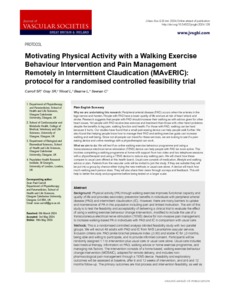Carroll, SP; Gray, SR; Wood, L; Bearne, L; Seenan, C
(2024)
Motivating Physical Activity with a Walking Exercise Behaviour Intervention and Pain Management Remotely in Intermittent Claudication (MAvERIC): protocol for a randomised controlled feasibility trial.
Journal of Vascular Societies Great Britain & Ireland, 3.
pp. 147-154.
ISSN 2754-0022
https://doi.org/10.54522/jvsgbi.2024.128
SGUL Authors: Bearne, Lindsay Mary
![[img]](https://openaccess.sgul.ac.uk/116512/1.hassmallThumbnailVersion/JVSGBI--Carroll%20et%20al.pdf)  Preview |
|
PDF
Published Version
Available under License ["licenses_description_publisher" not defined].
Download (971kB)
| Preview
|
Abstract
Background: Physical activity (PA) through walking exercise improves functional capacity and quality of life and provides secondary prevention benefits in individuals with peripheral arterial disease (PAD) and intermittent claudication (IC). However, there are many barriers to uptake and maintenance of PA in this population including pain and limited motivation. The aim of this study is to test the feasibility and acceptability of delivering a clinical trial to evaluate the effect of using a walking exercise behaviour change intervention, modified to include the use of a transcutaneous electrical nerve stimulation (TENS) device for non-invasive pain management, to increase walking-based PA in individuals with PAD and IC in comparison with usual care. Methods: This is a randomised controlled analysis-blinded feasibility study with two parallel groups. We will recruit 48 adults with PAD and IC from NHS Lanarkshire vascular service. Inclusion criteria are: PAD (ankle brachial pressure index <0.90) and stable IC for >3 months, being able and willing to participate, and to provide informed consent. Participants will be randomly assigned 1:1 to intervention plus usual care or usual care alone. Usual care includes best medical therapy, information on PAD, walking advice or home exercise programme, and managing risk factors. The intervention consists of a home-based, walking exercise behaviour change intervention (MOSAIC), adapted for remote delivery, and includes non-pharmacological pain management through a TENS device. Feasibility and exploratory outcomes will be assessed at baseline, after 6 and 12 weeks of intervention, and at 6 and 12 months follow-up. The primary outcomes are trial process and intervention feasibility, as well as intervention acceptability measured using rates of participant recruitment and retention, intervention adherence, and the Theoretical framework of Acceptability questionnaire. Exploratory outcomes include daily PA and patient-reported outcomes including quality of life, pain self-efficacy and catastrophising, and walking impairment pain intensity and quality. Conclusion: This trial will evaluate the feasibility and acceptability of a remotely delivered walking exercise behaviour change intervention adapted to include the use of a TENS device to improve PA in individuals with PAD and IC. Trial Registration Number: ClinicalTrials.gov Identifier: NCT06114732
| Item Type: |
Article
|
| Additional Information: |
https://jvsgbi.com/motivating-physical-activity-with-a-walking-exercise-behaviour-intervention-and-pain-management-remotely-in-intermittent-claudication-maveric-protocol-for-a-randomised-controlled-feasibility-trial/ |
| SGUL Research Institute / Research Centre: |
Academic Structure > Population Health Research Institute (INPH) |
| Journal or Publication Title: |
Journal of Vascular Societies Great Britain & Ireland |
| ISSN: |
2754-0022 |
| Publisher License: |
Publisher's own licence |
| Projects: |
| Project ID | Funder | Funder ID |
|---|
| UNSPECIFIED | Scottish Heart and Arterial Risk Prevention | UNSPECIFIED |
|
| Dates: |
| Date |
Event |
| 2024-05-16 |
Published |
| 2024-05-03 |
Accepted |
|
| URI: |
https://openaccess.sgul.ac.uk/id/eprint/116512 |
| Publisher's version: |
https://doi.org/10.54522/jvsgbi.2024.128 |
Statistics
Item downloaded times since 31 May 2024.
Actions (login required)
 |
Edit Item |


